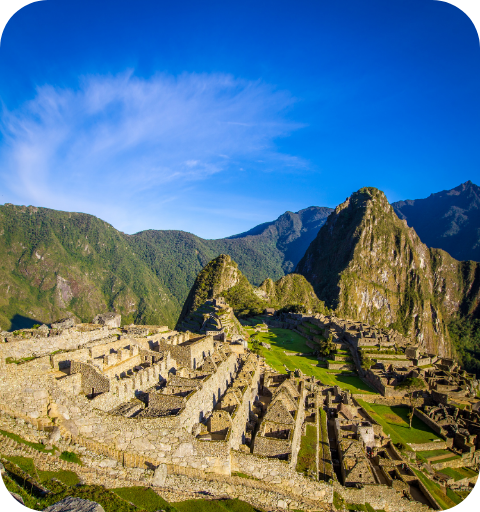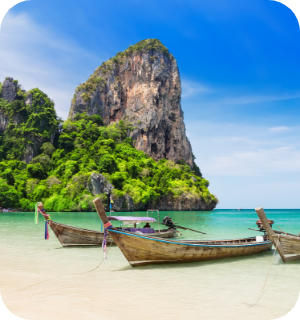Travel content writing is all about education and storytelling – travel guides, destination features, and in-depth articles that build trust with readers over time. Travel copywriting focuses more on persuasion and driving immediate action – the words on your website, in your emails, and on your ads that convince someone to book right now. Both are important, but they serve different purposes in your travel marketing toolkit.
I spent 10 years as a travel consultant before making the switch to copywriting. Those years talking directly with customers gave me invaluable insights into what travelers really want. Having explored over 50 countries myself, I’ve got plenty of first-hand experience to draw from when writing. This background helps me create authentic travel content that connects with readers because I’ve been on both sides – selling travel products and experiencing them myself.
Good travel content transports readers to the destination before they even book. It’s authentic, avoids clichés, and offers genuine insights rather than generic descriptions anyone could write. The best travel content balances practical information with emotional storytelling – giving readers both the facts they need and the inspiration they crave. And ultimately, it speaks directly to your ideal customers in a way that feels personal and natural.
SEO-focused travel content helps more people find your website on Google when they’re actively looking for what you offer. When you rank for the right keywords, you’re getting in front of travelers who are already interested in your destinations or services. This traffic tends to be higher quality than ads because these people are actively searching. Plus, unlike paid advertising that stops the moment you stop paying, good SEO content continues working for you month after month, building your authority in the travel space over time.
Content marketing is more of a marathon than a sprint. You’ll typically start seeing initial traffic improvements within 3-6 months, but the full benefits often take 6-12 months to really show up. That’s because search engines need time to index and rank your content, and your authority builds gradually. The good news is that once your content starts performing, it continues working for you for years with just occasional updates to keep it fresh.
Absolutely! Keyword research is essential for creating content that actually gets found. I identify search terms that your ideal customers are using, focusing on phrases with good search volume but reasonable competition. For travel businesses, this often includes destination-specific keywords, experience-based searches, and seasonal travel terms. I look beyond just the obvious high-competition terms to find those valuable niche opportunities where you can actually rank and bring in qualified traffic.
I’d be happy to help you plan your content strategically throughout the year. A good travel content calendar takes into account seasonal trends, booking windows, and your business priorities. We’ll identify key times when travelers are researching specific destinations, plan content that aligns with your promotional calendar, and ensure you’re publishing regularly enough to build momentum. The calendar gives you a clear roadmap while remaining flexible enough to adapt to changing trends or opportunities.
Each platform has its sweet spot. Blogs work well for detailed guides and SEO-focused content that brings in search traffic. Email excels at nurturing leads with personalized recommendations and timely offers. Social platforms vary – Instagram loves visual storytelling with stunning destination images, while Facebook often works well for travel tips and promotions. The key is adapting your core message to fit each platform’s format and audience expectations rather than just copying and pasting across channels.
I balance practical information with storytelling techniques that bring destinations to life. This means including the essential details travelers need – how to get there, where to stay, what to see – while weaving in sensory details and authentic experiences that create an emotional connection. I avoid generic descriptions and instead focus on specific, unique aspects of a destination. Personal anecdotes, local insights, and unexpected details help maintain interest while delivering useful information.
I offer both one-off projects and regular content creation packages. For ongoing work, my packages start from $1,139 (£899) for a set of 5 SEO blog posts, with options for other content types like email copy and product descriptions. Many clients find a monthly retainer works best for consistent content creation, which typically includes a mix of blog posts, social content, and email copy. The exact package can be tailored to your specific needs and budget.
Success metrics depend on your goals, but I typically track traffic, engagement, and conversion metrics. For SEO content, we’ll monitor rankings, organic traffic growth, and time on page. For conversion-focused content, we’ll track click-through rates, enquiry form submissions, and actual bookings. Beyond these numbers, we’ll also look at qualitative feedback – are customers mentioning your content when they book? Is your content being shared? These combined metrics give us a comprehensive view of performance.
Definitely! Your existing content is a goldmine of material that can be transformed for different platforms. A detailed destination guide could become a series of social media posts, an email sequence, or even a video script. I’ll help identify your highest-performing pieces and adapt them to work in different formats – extracting key tips for social, pulling out stunning visuals for Instagram, or condensing information for email. This approach maximizes your return on investment while maintaining a consistent message across channels.
I rely on official tourism board information, my own firsthand experiences from visiting 50+ countries, and trusted industry sources. For destinations I haven’t personally visited, I consult with local experts and travel professionals currently operating in those locations. I’m careful to verify details like opening hours, prices, and travel requirements from multiple sources before including them. Accuracy is crucial in travel content – nothing undermines trust faster than outdated or incorrect information.
I tailor the content’s focus, tone, and practical details based on who you’re trying to reach. For luxury travelers, I might emphasize exclusive experiences and personalized service. For families, I’ll highlight kid-friendly activities and practical logistics. Budget travelers want insider tips on maximizing value, while adventure seekers care about authentic, off-the-beaten-path experiences. The key is understanding each audience’s specific motivations, pain points, and desires, and then addressing those directly in the content.






















